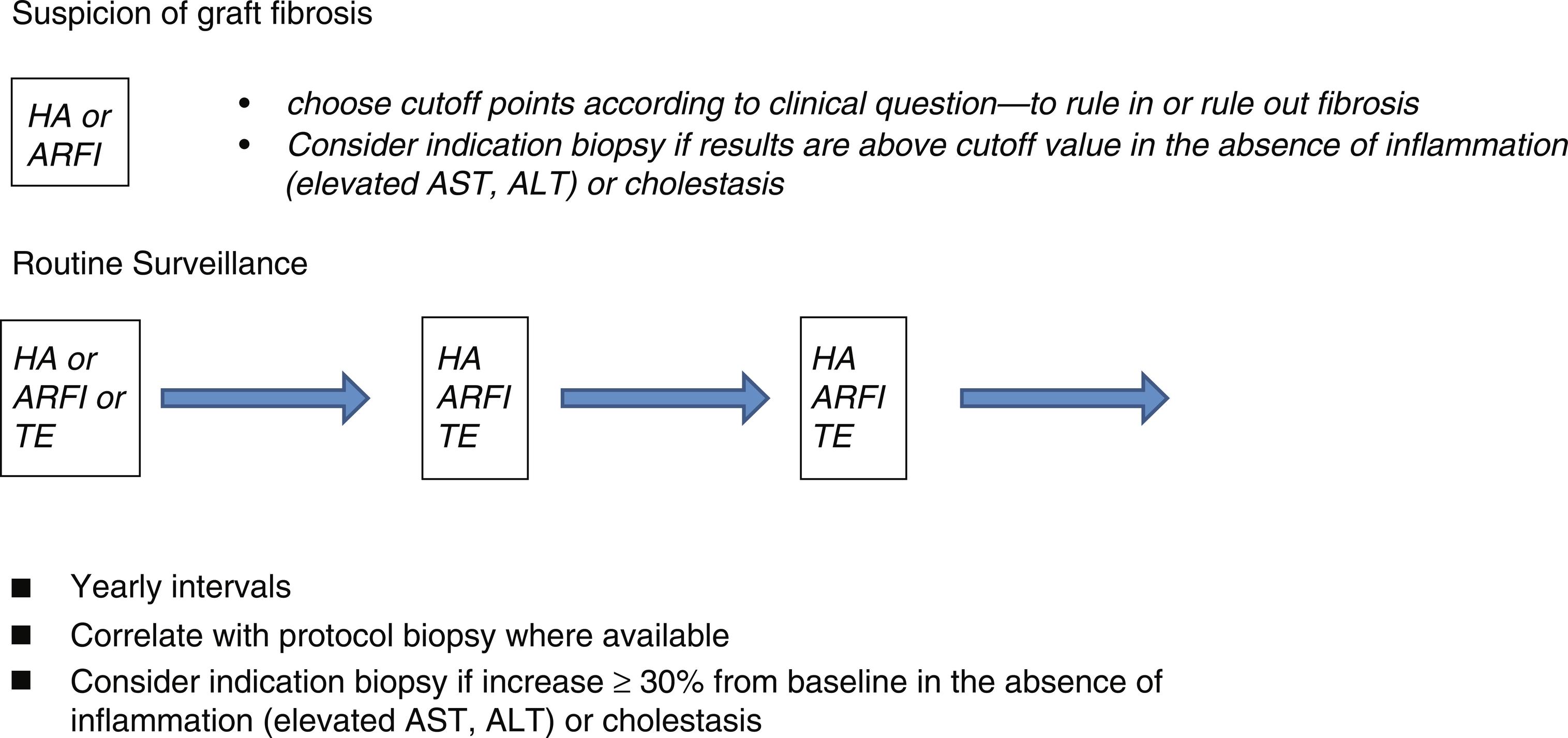Physical Address
304 North Cardinal St.
Dorchester Center, MA 02124
Over the past decades, survival rates after pediatric liver transplantation have increased from about 76% to over 90% more than 10 years after transplantation (Tx). Follow-up care of liver-transplanted children includes both monitoring of graft functioning and monitoring for associated comorbidities. Monitoring the allograft is comprised of a number of features, ranging from the innate hepatic metabolic and synthetic functions to late surgical complications, such as biliary and vascular obstruction, and to transplant-specific, immune-mediated complications, such as graft fibrosis, graft hepatitis, and acute or chronic rejection.
Protocols for follow-up care are usually comprised of regular evaluation of routine biochemical liver function tests (e.g., transaminase levels, parameters of cholestasis, parameters of hepatic synthetic function), as well as ultrasound examinations to monitor hepatic vasculature and hepatic morphology.
Hepatic synthetic and metabolic function can easily be monitored by routine biochemical parameters. Biliary obstruction will usually manifest first by biochemical changes such as raised bilirubin and gamma-glutamyltransferase (GGT) levels and, in advanced stages, might cause clinical signs and symptoms such as jaundice, pale stools, and pruritus and possibly dilation of bile ducts detectable on ultrasound. Acute rejection will be suspected in cases of raised transaminase levels, but confirmation requires liver biopsy.
Chronic graft changes such as graft hepatitis, graft fibrosis, and chronic rejection might be present even in the presence of normal or near-normal biochemical liver function tests, rendering early stages almost unrecognizable for routine follow-up. Again, their detection requires liver biopsy. The use of protocol biopsies at regular intervals after pLTx has not yet been universally endorsed by pediatric liver transplantation (pLTx) centers. Published series of late protocol biopsies after pLTx indicate a prevalence of graft fibrosis of 70% more than 10 years after pLTx, and a prevalence of chronic inflammation (graft hepatitis) of about 60%.
The main aim of integrating serological biomarkers into the routine monitoring of the liver allograft would be to identify graft changes and dysfunctions that cannot be detected by routine biochemical parameters. Biomarkers that could potentially obviate the need for liver biopsy in (pediatric) liver transplantation have been evaluated for the diagnosis of acute cellular rejection and for the diagnosis of graft fibrosis.
Graft fibrosis can be detected in up to 30% of grafts 1 year after transplantation and increases in frequency over the years. Graft fibrosis is seen in 60% to 80% of grafts 10 years and more after pLTx. Fibrosis is accompanied by some degree of inflammation in more than 50% of cases.
Over the past decade, a number of approaches have been developed and tested to facilitate the noninvasive diagnosis of hepatic fibrosis without recurrence to liver biopsy. These approaches include imaging—namely, ultrasound and magnetic resonance imaging (MRI)-based techniques—and serological markers of fibrosis. One unifying feature for all these approaches is that they were primarily developed in adult hepatology, predominantly in the context of adults with hepatitis C, and in a pre-transplantation setting. Transfer of knowledge to the context of pLTx has been slow, thereby limiting the applicability of results for pediatric transplant hepatologists further (see Figure 30.1 ).

Serological biomarkers for the diagnosis of hepatic graft fibrosis can be divided into markers of hepatic fibrogenesis and extracellular matrix (ECM) deposition and markers that indicate the functional sequelae of hepatic fibrosis ( Table 30.1 ).
| Available Data | |||||
|---|---|---|---|---|---|
| Test | Adult LTx | Pediatric CLD | Pediatric LTx | Numbers of Patients in Biopsy-Controlled Studies after pLTx | Diagnostic Value in pLTx |
| Hyaluronic acid | + | + | + | n = 28 8 | Rule in, rule out fibrosis |
| ELF | + | ++ | + | n = 23 14 | No |
| FibroSure | ++ | + | + | n = 28 14 n = 5 (8 biopsies in 5 patients) 16 |
No |
| APRI | + | ++ | ++ | n = 39 20 n = 36 21 n = 38 22 n = 30 23 |
Limited |
| FibroScan | ++++ | ++++ | ++ | n = 36 14 n = 36 21 n = 16 30 |
Serial follow-up, not as a single shot |
| ARFI | ++++ | +++ | ++ | n = 23 35 n = 30 23 |
Diagnose, or rule out significant fibrosis; not for lower degrees of fibrosis |
| MRI elastography | ++ | ++ | – | Unknown | |
Markers that build on circulating levels of ECM components and factors of ECM degradation are the FibroSure (FS) test and enhanced liver fibrosis (ELF) score:
The FS test uses the ECM component alpha-2-macroglobulin with apolipoprotein A1, alanine aminotransferase (ALT), GGT, bilirubin, and haptoglobin.
The ELF score combines the ECM components of hyaluronic acid and the amino terminal peptide of type III procollagen with a factor of ECM degradation, tissue inhibitor of metalloproteinase-1.
In addition, the ECM component hyaluronic acid has been individually assessed as a marker for hepatic fibrosis.
To date, hyaluronic acid (HA) has been assessed in one small cohort of 40 children after liver transplantation, the majority of whom underwent protocol biopsies. Fibrosis was present in only 12.5% of the studied transplantation cohort, thereby limiting the possibility to calculate meaningful cutoff values. Healthy children universally displayed HA levels below 30 ng/mL. A HA level of 50 ng/mL appears to be a sensible cutoff value to rule out significant fibrosis (Ishak staging system, ≥ F3). A HA level of 200 ng/mL lacks sensitivity but is highly specific for the diagnosis of significant fibrosis.
Become a Clinical Tree membership for Full access and enjoy Unlimited articles
If you are a member. Log in here